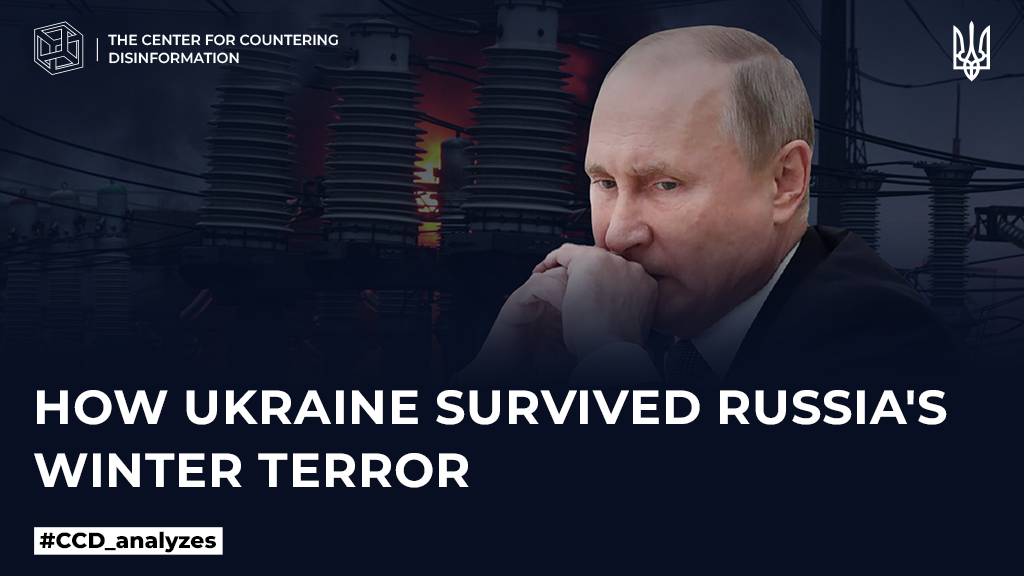The winter period of 2022-2023 turned out to be another test of strength for Ukraine and Europe. Having no significant victories on the battlefield, the kremlin changed its tactics towards energy terror. The russians really hoped that without their energy carriers, the EU would become more “responsible” in the decision to provide military aid to Ukraine, and the Ukrainian government, with an energy system destroyed by russian missiles, simply would not survive the winter and would be “demolished” by angry Ukrainians.
putin convinced the russians and himself that he had chosen a win-win tactic, and dreamed that the threat of cold and starvation would become the most powerful tool of informational and psychological pressure on Ukraine, the European Union, and NATO. russian propaganda in various languages painted apocalyptic scenarios in which Europeans and Ukrainians freeze in their houses without heating and electricity and demand to go to a peace treaty with putin. Video stories about British women who allegedly cannot pay utility bills and are forced to “go to the panel” or Germans who “ate dog food and pets” due to lack of money for groceries have become a favorite topic of russian television.
Since October 10, the russian invaders tried to freeze Ukrainian cities and villages with the largest shelling of critical infrastructure since the Second World War. Drone attacks and missile strikes disabled more than 40% of energy facilities in Kyiv region, Kharkiv region, Lviv region, Vinnytsia region and other regions of Ukraine (since October 2022, russia has launched 255 strikes on 112 energy infrastructure facilities in Ukraine). In addition to large-scale destruction due to constant missile and drone attacks, the Ukrainian energy system lost more than 10 GW of the main installed capacities, which are temporarily under the control of the enemy (the key loss is the Zaporizhia NPP, the largest in Ukraine and Europe). Since October 20, restrictions on the supply of electricity were introduced throughout Ukraine, but russia was unable to achieve a complete shutdown of electricity. Ukrainians had to adapt to power outages, lack of water and heating. Generators, power banks, and charging stations were included in the list of the most demanded goods this winter. First of all, thanks to the professionalism of Ukrainian energy workers, the situation was contained, all types of generation are working in the power system, there is no shortage and it is not yet forecast. This made it possible to abandon “fan” blackouts and return street lighting and electric transport to the city. An abnormally warm winter was only one of the factors that made it possible to withstand a critical drop in generation due to shelling. At midnight from February 23 to 24, 2022, Ukrainian energy engineers disconnected the energy system of Ukraine from russia and belarus and already on March 16, Ukraine became part of the single energy system of the European Union (ENTSO-E). This made it possible not only to maintain the energy balance, but also to export the remaining electricity to Moldova, Romania, and Slovakia. According to the management of Naftogaz of Ukraine on the air of the telethon, the heating season is taking place regularly, gas reserves in underground storages and volumes of own production are sufficient for its timely completion.
It was also possible to stabilize the fuel crisis – during the autumn-winter of 2022-2023, the Ukrainian fuel market was completely rebuilt from russian to European supplies. By the middle of July, Ukraine satisfied the need for diesel fuel, in September – with gasoline. Currently, the demand for gasoline and diesel in Ukraine has returned to pre-war levels, fuel prices have increased, but there are no queues at gas stations.
moscow’s hopes that Europe would freeze without russian gas were also not confirmed. Although, as early as 2021, in preparation for the war in Ukraine, the kremlin purposefully reduced gas reserves in European gas storage facilities under its control, as well as limited transit through the Ukrainian gas transportation system, the oil and gas blackmail attempt was defeated. A relatively warm winter, diversification of gas supply sources and gas reserves helped prevent an energy crash and dash the russian dictator’s hopes. Moreover, by giving up russian gas, the European Union saved 12 billion euros.
A pessimistic forecast awaits the aggressor state itself next winter. According to the calculations of Reuters experts, russia’s share in the gas market of the European Union has decreased from 40% (in 2021) to 7.5% (in 2022), so russia’s export revenues from the sale of gas to European countries in 2023 may fall in half.
❗️Thus, the russians’ “horror stories” about the total blackout of Ukraine and the evacuation of millions of people on the eve of the heating season did not come true, as did the plan to blackmail Europe with gas and force negotiations on the kremlin’s terms. Despite hysterical forecasts, Ukraine welcomed spring with light, warmth and absolute faith in victory.










